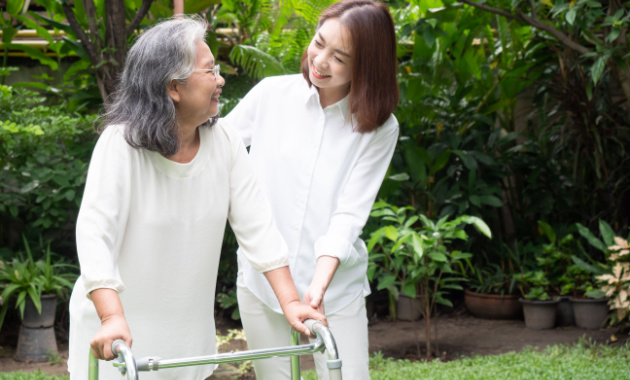
Chronic pain is prevalent among 25-85% of older individuals[1]. Unfortunately, pain frequently goes unnoticed, receives inadequate treatment, or remains untreated. This oversight can substantially diminish the quality of life, potentially triggering depression, anxiety, heightened suicide risk, increased dependency, decreased appetite, compromised mobility, sleep disruptions, and various other challenges[2].
Reasons for Undertreated Pain in Seniors:
5. Fear of Loss of Self-Reliance: Often, elderly patients may underreport pain due to intense and irrational fear of losing their independence, self-sufficiency, or ability to care for themselves[2].
Addressing these factors is crucial for improving pain management in the geriatric population.
Here are 5 ways to help the elderly manage their pain:
1. Provide Orthopaedic Support: Orthopedic support aids prove invaluable for seniors facing musculoskeletal challenges. Products like knee support, back braces, and sleeves offer precise, pain-relieving reinforcement. Tailored to fit and designed for optimal comfort and efficacy, these aids promise exceptional relief and support.
Explore a range of Supports, Splints, and Braces!
2. Encourage Mobility: Assistive devices like walking aids (canes, walkers) provide vital physical support for seniors, enabling active participation in daily activities and upholding their self-reliance. These devices serve as aids that counter mobility limitations, empowering older individuals to navigate their surroundings and accomplish tasks with reduced dependence on external help.
If your loved ones are facing issues with daily mobility, provide them with the appropriate orthopedic support. Choose from the range of walking sticks, wheelchairs, etc.
3. Care for their Bones, Muscles, and Joints: In the pursuit of taking care of external needs, internal care often gets neglected. Diminished muscle strength and balance correlate with heightened fall susceptibility and reduced bone mineral density[3]. Ensure a strong foundation for your elderly by strengthening their bones, muscles, and joints.
Support healthy and pain-free aging. Choose bone, muscle, and joint care for seniors. Check out here!
4. Opt for Vitamins and Supplements: Many naturally occurring substances like herbs, spices, and omega fatty acids in the form of supplements are known to relieve pain. Derived from the ginger family, turmeric, a potent root, is renowned for its inflammation-reducing properties. Incorporating this spice into cooking or making a soothing tea can help alleviate pain in the elderly.
Choose supplements for pain relief and promote comfort. Explore here!
5. Talk to Them: Coping with pain is a challenging journey. Some people suffering from pain can show signs of fatigue, anxiety, depression, and irritability, intensifying a negative cycle. You need to show compassion and ask them if they feel pain. Motivate them to talk to you or enroll them in talking therapy wherein they can connect with others who have shared similar pain experiences and truly comprehend the struggles for valuable support.
6. Encourage to Take Deep Breaths: Deep breathing is a potent method for alleviating pain in older people. Slow, quiet breaths relax the body and mind, providing comfort. Additionally, concentrating on proper breathing during moments of pain can yield positive results. Intense pain often triggers shallow, rapid breaths that may induce dizziness, anxiety, or panic. However, choosing deliberate, unhurried breaths promotes a sense of control and relaxation, and prevents the escalation of muscle tension and anxiety, effectively mitigating the impact of pain.
7. Practice Relaxation Techniques: Regular relaxation techniques can effectively diminish persistent pain. These techniques span from massages to diverse forms of meditation. Meditation eases pain by reducing stress, altering pain perception, and releasing natural pain-relieving endorphins, enhancing overall well-being and promoting better sleep. Help older adults to meditate. Gently massage the feet, back, or hands of your loved ones using your entire hand, palm, or fingertips, applying gradual and circular pressure.
8. Motivate to Do Physical Exercises: Physical exercises like walking and strengthening can enhance mobility, mood, and pain management. Gentle stretching can help reduce pain by relieving muscle and joint stiffness.
9. Other Common Therapies: Pain-relieving medicines like acetaminophen, ibuprofen, or naproxen sodium, along with topical ointments and patches, can provide relief. Additionally, applying heat or ice can be beneficial. Heat effectively soothes muscles and spasms, while ice suits joint pain and swelling. In cases of acute pain, an initial 48-72 hours of ice is recommended to reduce inflammation, followed by a switch to heat to facilitate healing. Psychological therapy, like Cognitive Behavioral Therapy, can be incorporated for mastering chronic pain self-management. A lesser-known TENS or transcutaneous electrical nerve stimulation helps alleviate pain by employing gentle electrical currents that induce muscle relaxation and activates the body’s natural pain-relieving endorphins[4].
No matter what type of muscular pain you get, try these balms and sprays for instant relief.
Irrespective of whether the pain is recent or long-standing, these proven self-help measures offer relief pathways. While many discomforts can be effectively addressed at home, especially for older adults, it’s essential to promptly reach out to your doctor for advice if you observe any unusual symptoms.
(The article is written by Dr.Subita Alagh, Senior Executive, and reviewed by Monalisa Deka, Senior Health Content Editor)
References
1. Stompór M, Grodzicki T, Stompór T, Wordliczek J, Dubiel M, Kurowska I. Prevalence of Chronic Pain, Particularly with Neuropathic Component, and Its Effect on Overall Functioning of Elderly Patients. Med Sci Monit. 2019;25:2695-2701. Available online: https://www.ncbi.nlm.nih.gov/pmc/articles/PMC6475124/
2. Schwan J, Sclafani J, Tawfik VL. Chronic Pain Management in the Elderly. Anesthesiol Clin. 2019;37(3):547-560. Available online: https://pubmed.ncbi.nlm.nih.gov/31337484/
3. Hillsdon M, Foster C. What are the health benefits of muscle and bone strengthening and balance activities across life stages and specific health outcomes? J Frailty Sarcopenia Falls. 2018;3(2):66-73. Available online: https://www.ncbi.nlm.nih.gov/pmc/articles/PMC7155322/#:~:text=Preserving%20muscular%20strength%2Fpower%20in,and%20lower%20bone%20mineral%20content.
4. Vance CG, Dailey DL, Rakel BA, Sluka KA. Using TENS for pain control: the state of the evidence. Pain Manag. 2014;4(3):197-209. Available online: https://www.ncbi.nlm.nih.gov/pmc/articles/PMC4186747/